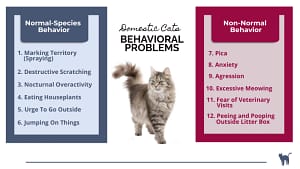Cat aggression towards dogs is quite common. Dogs and cats are natural foes, and instincts prevail if they haven’t grown up together.
Below are the six most typical reasons for cat aggression:
- Pain-induced aggression,
- Fear-induced aggression,
- Territorial aggression,
- Redirect aggression,
- Play aggression,
- Non-recognition aggression.
The good news is that cats and dogs can be trained to get along by taking these 6 steps:
- Step 1: Use smell to familiarize the two pets.
- Step 2: Keep the cat and dog separate.
- Step 3: Bring them together gradually.
- Step 4: Make sure the cat feels safe.
- Step 5: Pay attention to the cat’s stress level.
- Step 6: Give your cat a lot of playtime.
- Does your cat behave aggressively towards dogs?
- Do you want to adopt a dog but are you afraid that your cat will take it the wrong way?
- Has your cat suddenly become aggressive towards your dog?
It’s crucial to remember that dogs are natural cat predators. As a result, cats have a long history of conflict with dogs. This means you should take cat-to-dog aggression seriously as it can cause harm to both animals.
However, if they grow up together since they are very young, they are more likely to get along. This is why cats and dogs frequently live together in any typical household.
But some cats just don’t like dogs. And finding the main reason can be a challenging task.
This article will help you grasp the underlying causes and provide solutions to this critical problem, so keep reading.
Why Is My Cat Suddenly Aggressive Towards My Dog?
There are many reasons why cats get aggressive toward dogs. The most common is related to fear.
But there are other ones like defense, territoriality, redirection, rough play, or pain. All of these factors can act as catalysts.
On the bright side, as you’ll see later, aggressive cat behavior toward dogs is a problem with solutions.
When a cat feels threatened by a dog, it has two choices available:
- Escaping and hiding, or
- Attacking and fighting back.
When the second scenario happens, keep in mind that cats are fully aware that they inflict significant injury to the dog. Because the dog’s nose and eyes are so sensitive, the face is their greatest choice.
This is why you need to understand the factors contributing to a cat’s aggressive behavior: to protect your dog from getting real injuries. Identifying the triggers will let you put a stop to your pet’s hostile behavior.
The first step we need to make to reach this goal is to understand the context. In general, if your cat attacks or scratches the dog, it might be for one of the following reasons:
# 1 Pain-induced Aggression

Your cat’s aggressive behavior towards your dog might be the result of an underlying medical condition.
When cats are in pain, they become aggressive. They want to avoid any contact that would worsen their suffering.
Spotting their conditions can be difficult at first. That’s because cats have mastered the art of hiding pain as a survival mechanism.
The medical condition may be:
- Arthritis,
- An infection,
- A recent operation, or
- A neurological disorder.
Cats suffering from osteoarthritis, for example, may hiss, bite, or scratch your dog if he touches his joints.
Even the most well-established cat-dog bond might be temporarily disrupted when a cat is wounded.
Once the pain is gone, the aggressive behavior usually goes away.
I recommend you leave no stone unturned by getting medical help from a veterinarian.
# 2 Fear-induced Aggression

Fear is the most likely driving factor for cats attacking dogs. Introducing a new dog might cause stress in your cat, provoking an aggressive reaction.
In fact, cats are sensitive even to the slightest change in their environment. Essentially, the stress helps keep the new dog away and safe, so in a way, it’s reinforcing.
The main tell-tale signs that your cat is stressed at the sight of the new dog are hissing and scratching. And if it’s helping keep the dog away or make you come over and stop the interaction between the two, your cat will do it again.
When a cat feels trapped, he adopts a defensive body posture. He will stoop to make himself look smaller. He will also flatten his ears and wrap his tail around his body.
If the dog does not back off, your cat may interpret the dog as attempting to harm him and will lash out in self-defense.
What should you do?
Try making your cat calmer and safer can help relieve its stress. Later you’ll see some options you can choose from to achieve this.
Meanwhile, let’s get to the next type of aggression.
# 3 Territorial Aggression
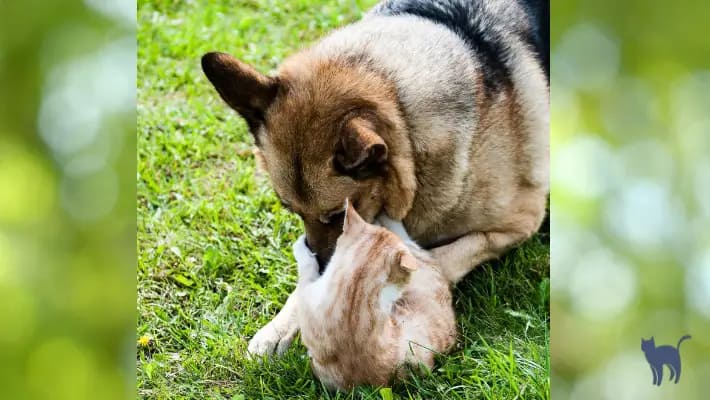
Despite their domestication, cats are instinctively territorial creatures. Most of them need territory to establish and assert dominance over other pets.
It is a way of preserving “his or her resources.”
Attack behavior is the most normal reaction if your cat perceives the dog as a threat.
Your cat will try to set boundaries and show the dog who is in charge. If the dog is docile and does not fight back, the cat will take advantage of this by being even more intimidating.
In short, the kinder your dog is, the more aggressive your cat will be.
This sort of behavior is most common when a “new dog” enters a home where a cat already feels like the territory lord.
He will also be upset if his owner’s attention is diverted to another pet.
# 4 Redirect Aggression

Redirected aggression occurs when a cat becomes frustrated or agitated by a stimulus that it cannot reach.
External stimuli like smell, other animals, or noise can cause the build-up of your cat’s aggression levels.
Let’s say your cat sees or hears something she wants to ambush but can’t get to it, such as a bird outside the window. With such aggression build-up, suppose your dog happens to cross the cat’s way; the cat may lash out at the dog.
Since this happens most times unexpectedly there isn’t much you can do about redirected aggression. Just try setting up a more relaxing environment your cat can live in.
Remember, the cat will not go looking for the dog to attack! It is not a malicious or intentional act of aggression. It’s as though a reaction occurs instinctively and without thought.
# 5 Play Aggression

Play aggression includes predatory behaviors such as stalking, chasing, attacking, running, grabbing, fighting, and biting.
The idea of attacking is ingrained in their minds, and kittens learn their first hunting lessons through play. They also learn how to play properly by playing with their littermates.
If your cat plays rough with your dog, he may have been separated from his or her mother too soon. As a result, he or she may have never learned to control his or her play behavior.
Other variables, such as a lack of mental and physical stimulation, might also lead to play aggression toward dogs. They are simply bored.
However, there’s a chance your dog is experiencing the same issue. Dogs in this situation do not respect cats’ limits and get “too” affectionate with them.
Even if the dog is only trying to play, your cat might find it irritating. As a result, your cat attacks the dog.
# 6 Non-recognition Aggression

This sort of hostility happens when a cat exhibits aggressive behavior after a time of separation. For instance, when the dog returns home from the vet.
In this case, the dog has a distinct smell your cat does not recognize. Worse, the dog’s stench is more akin to alcohol or disinfectant, reminding your cat of a previous negative experience at the vet’s office.
For your cat, this may be a very stressful and frustrating circumstance. And that might be the source of the cat’s animosity toward your dog.
How to Stop Cat Aggression Toward Dogs
If you are still having trouble finding the reason behind your cat’s aggression, then you should factor in proactive solutions.
You should know that a cat’s bite can turn infectious really fast. Also, many dogs suffer from corneal ulcers, courtesy of cat scratches.
Likewise, dogs can get aggressive too, causing serious injuries to cats too, it might cause your cat serious injuries.
So, if you want to keep both parties safe from one another, then the following insights will show you what to do:

Step 1: Use Smell to Familiarize the Two Pets
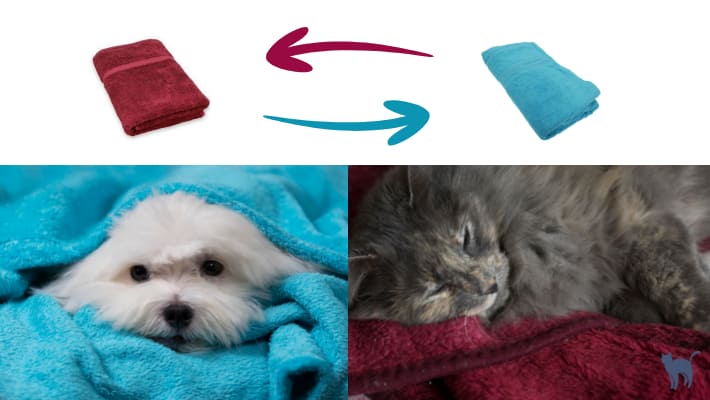
We can use cats’ and dogs’ powerful sense of smell to treat behavioral issues.
For instance, when you adopt a new kitten, experts recommend bringing home a blanket with the mother’s scent on it. This helps the newcomer settle in properly.
Similarly, you can use the same approach to socialize the two pets. It’s a good idea to share each of their scents with the other before they meet.
You can do it by giving them each a blanket from the other’s bed.
And let me tell you: it worked wonders for me!
In fact, when I introduced my cat Junior to our house, I had to deal with my neighbor’s dog since we shared the same garden.
Here’s what I did:
- I used the cat’s blanket and the dog’s blanket,
- I rubbed the cat’s blanket into the dog’s fur,
- I rubbed the dog’s blanket into the cat’s fur,
- I put them back in their respective beds.
That’s it!
They were confused at first because they detected the new smell but also recognized their scent and did not reject the blanket.
Over time the smell became familiar to them and their initial distrust disappeared. It took about 30 days for me to feel at ease leaving them alone, but it worked.
Step 2: Keep the Cat and Dog Separated
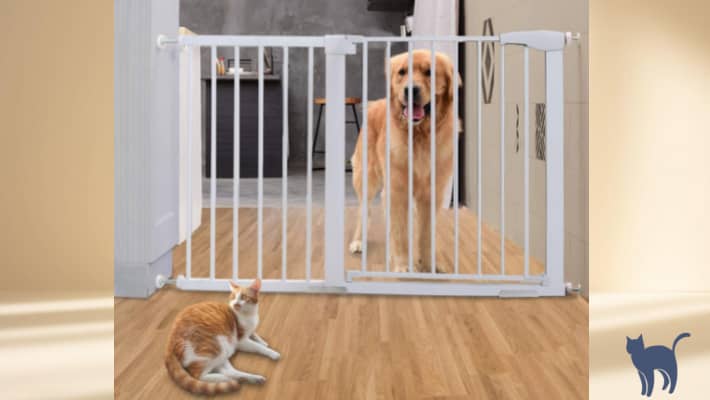
Keep the newcomer separated from current family pets. Crates, pet gates, and closed doors can all be used. Both must have their place at first.
Allow your pets to smell and get to know one other while they are protected by barriers.
Pay close attention to them while they face each other until it is evident whether they accept, ignore, or can’t stand each other.
Depending on which pet is entering a home and which is living there, there are different approaches you should take:
- The cat is living at home and the dog is adopted.
Assure the cat’s safety by allowing access to all places save the one where the dog is temporarily housed. This will send a message to the cat that nothing will be taken away from him. Then, under supervision, gradually bring the dog into the cat’s territory. Based on their reactions, you may increase the amount of time they spend together. - The dog is living at home and the cat is adopted.
Keep the cat in a small space at first so that it gets used to the new surroundings. The unfamiliar scents, noises, and environment might be highly stressful for the newcomer. Allow the dog to visit the cat’s domain only after you have provided it with high-up locations where the dog cannot reach the cat.
Be patient. It might take weeks or even a few months to fully integrate a new pet — especially if you’re dealing with a fearful or aggressive kitty.
Step 3: Bring Them Together Gradually
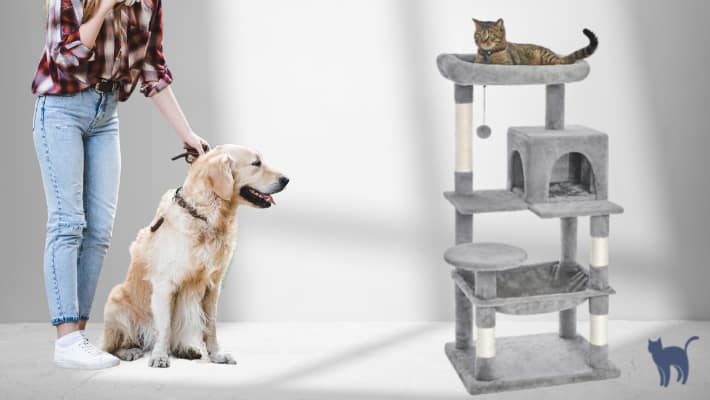
This is the most difficult aspect since you have no idea how long it will take. It depends on each pet’s personality.
For example, if you have a fearful kitten and a really friendly dog, it will take longer since the dog will most likely break the cat’s boundaries too soon.
Start by allowing them to be together for brief periods under supervision. Keep the dog on a leash and at a safe distance from the cat.
You can move the dog closer as long as the cat stays calm in the dog’s presence. Pay particular attention to the cat’s body posture, such as ears flattening, tail wrapping around the body, or hissing.
All these signs state that your cat is anxious. If this is the case, bring the dog back and try again later.
You can speed up the process by praising the cat anytime the dog comes close. You can give him his favorite snack. This way, your cat will get used to the dog’s presence and start feeling less stressed and more comfortable.
This is known as “Desensitizing” the cat. The cat will soon grow indifferent to the dog’s presence. However, you must move carefully and separate them as soon as you see an unpleasant response.
Sometimes the cat gets aggressive against the dog only when the latter approaches certain areas, such as the food bowl. In this scenario, use the same method as described before.
This will show the cat that nothing will be ripped away from him.
It is also critical to properly train your dog to treat the cat properly which includes teaching it how to respect the cat’s boundaries.
Step 4: Make Sure the Cat Feels Safe

You must give your cat its own space, a place to hide if she feels threatened.
Make sure there’s an escape route accessible by the cat but inaccessible to the dog.
You can do this by providing an exit route, which could be one of the following two:
- A horizontal exit, a small entrance at the bottom of the door is a good option. Your cat will be able to leave the room without the dog following him. Take, for example, this lovely indoor cat door.
- A vertical exit, a large cat tree, or some raised ledges or pathways are all options. Your cat will be able to climb up and quickly keep a safe distance from the dog. There is also an example here.
As a result, the cat will be aware that if she feels threatened by the dog, she can seek refuge anywhere the latter cannot reach him.
This will provide the cat with essential peace of mind, and she will be more likely to accept the dog during this critical adaptation phase.
Step 5: Pay Attention to the Cat’s Stress Level
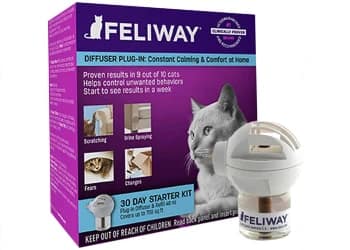
This situation could be very challenging for everyone involved, especially for your cat.
You should take all possible measures to lower your cat’s stress levels.
How can you do so?
Beyond providing a safe space to hide and relax, experts recommend applying the following suggestions too:
- Use a pheromone diffuser.
FELIWAY® is the most well-known and highly recommended product. It is a brand that specializes in feline behavior control.
Their products are based on pheromones, which are the chemical signals cats use to communicate.
FELIWAY® contains a synthetic replica of cat pheromones as well as a trace of catnip.
These components make cats more relaxed, comfortable, and safe. It amplifies their olfactory signals, which relaxes them and improves their behavior.
As a consequence, their relationships with other animals improve. - Separate the feeding area.
Dogs and cats have very different ways of eating.
Dogs often gobble up their meals all at once and quickly. Cats instead, move slowly and need to feel safe while doing it.
To avoid stressing your cat too much, separate them and let them eat alone each other.
Step 6: Give Your Cat Lots of Playtime
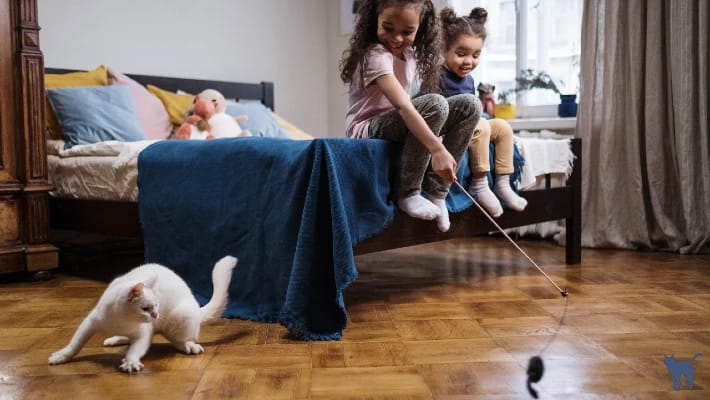
According to researchers in the cat behavior field, playtime with their owners is what cats enjoy the most. As a second benefit, it also keeps your cat mentally and physically active, which increases his welfare.
The goal is to exhaust your cat so his build-up energy could be released safely.
Let’s say your problem is not about introductions, but rather play-aggression. Cats with high prey drive tend to pester and chase small dogs and pups to play with them.
For example, your cat may decide to pounce on the wiggly tail of your house dog. If the dog is bigger than the cat, it might lash out and inflict serious harm to your cat.
If you notice this situation; stop it before it escalates further.
A better solution is redirecting the cat’s attention to a different form of play that won’t leave either party with injuries.
You can use a wand toy with feathers at its tip. They are perfect toys because they move like prey and keep your cat away from your body and your dog.
Consider having catnip toys around the house as well. They will keep your cat entertained.
When it comes to playtime, set aside 30 to 45 minutes every day. You can schedule these sessions into 10-15 minutes each. That’s because most adult cats cannot stand long sessions.
You can also place a leash on your dog. This way, in case your cat wants to play, it will focus on the leash instead of going directly for your dog.
By doing so you avoid the cats going directly for the dog itself.
How to Separate Cats and Dogs Fighting Each Other

Your pets eventually could chase after each other and start fighting.
When this happens, avoid separating them directly.
Screaming is also not a good option since we know that our pets perceive our emotions and become agitated just like us.
You can use one of three methods to safely separate them without exposing yourself:
- Throw a blanket over both of them. By obstructing their visibility, you will draw their attention elsewhere.
- Make a very loud noise. You may strike two pot covers. The unexpected sound will shock them and draw their attention to the source of the noise (which is different than screaming at them).
- Use water. This is only recommended as a last resort and only if the first two options have failed.
Use the “wheelbarrow” method. This strategy will come in handy if your dog tries to fight back against your cat. It consists of raising the dog’s two hind legs. The dog will be unable to chase your cat, and the latter will flee.
Does My Cat Keep Attacking the Dog?
On rare occasions, all your efforts might not be enough. Your cat will still show aggression toward your dog without any identifiable trigger.
The cat may be fine at one moment, but then start hissing at the dog later.
At this point, it could be very difficult for you to determine the underlying reason for the aggressiveness.
If this happens you must get to the bottom of it. Consider speaking with an animal behaviorist or your vet.
They can help you understand why your cat just won’t accept your dog.
They will also have certain techniques to reduce possessiveness and engender a feeling of security in your cat.
Is My Cat Attacking or Playing With My Dog?
Cats have different personalities, just like dogs. Some cats and dogs will share everything from toys to food, sleep in the same bed, play together and become very close friends.
Others don’t like each other that much, and both parties should stay out of each other’s lanes for peace’s sake.
Sometimes, you may see a cat and dog playing just fine one minute, and the next minute, all hell breaks loose, and it’s all chaos with the two. So it’s crucial to identify when your cat is attacking or playing with the dog.
But how can you know when your cat is playing with the dog?
According to PetSafe, cats are in the play mood when they elevate their butt before pouncing or swiping your dog’s.
On the other hand, dogs bow more than usual.
Also, the two may act as subordinates to one another to invite play. Once you notice one running from the other in a search for an escape route, then most definitely, something is wrong. And you should intervene to separate them.
How Long Does It Take for a Cat to Get Used to a Dog?
If you’re lucky, you might hit it off right away. However, some cats can take around two weeks, some a month, while others may take longer.
Essentially, it comes down to the personalities of both animals.
Make sure you have a solid introduction plan if you intend to adopt a new dog into your home. Note that proper pet introduction ensures the two get used to one another quickly.
It will also take a long time for the two to tolerate each other.
The cat’s confidence is crucial in determining how quickly he will get along with the dog. The cat will eventually realize that the dog is not a threat and will accept his company in peace.
If your idea was to throw the dog into the mix and hope for the best, then expect the worst. A good rule of thumb is to move slowly.
Supervising the whole intro process will help prevent aggressive cat behavior against dogs.
Final Remarks
Whether you have a new puppy or an established one, you need to pay close attention before things get south.
Your cat may be frightened, which might be one of the reasons he gets aggressive against the dog.
This article emphasized how knowing the causes of a cat’s aggression toward a dog is important.
Fear-induced aggression, territorial aggression, redirected aggression, rough play aggression, and non-recognition aggression are all possible motivators.
Identifying the cause will help you establish the correct course of action.
It’s also imperative to role out any underlying medical conditions and takes the cat to the vet.
We have also seen how to stop feline aggression in cases of introducing a new dog into the home.
The importance of following the steps and their sequence is the key to success. You must be patient and work intelligently and gradually.
We begin by introducing the scents, followed by a visual presentation without physical touch, then physical interaction under supervision, and lastly the option of leaving them alone.
Every process needs a significant amount of effort on your behalf. Taking care of a pet is a huge responsibility.
Still the unconditional love and the joy they give us compensate for all our efforts.
Wouldn’t you agree?
If you’ve experienced a similar pet problem or feel there’s a part we’ve not covered here, please let us know in the comment section below.







